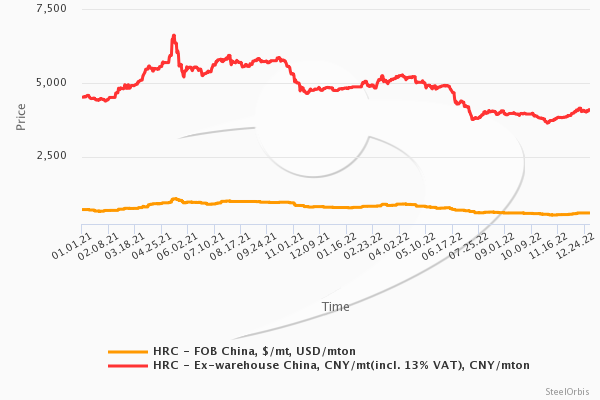2022 was another year of declining steel demand and production in China, confirming that the country has entered a new era of a plateau for consumption after the previous period of significant rises. This year, the performance of the real estate industry has been the worst in years and China’s zero-Covid policy has resulted in an overall slowdown in consuming industries. Chinese mills have been suffering from rising costs and the reduction in steel production has been just the logical result of these developments. For next year, stability is awaited from the Chinese steel market, with some negative bias, which, however, may depend on many uncertainties such waves of Covid infections and government stimuli.

Fundamentals cause slowdown
According to SteelOrbis’ calculations, China’s apparent crude steel consumption slipped by 1.9 percent year on year to 883 million mt in the January-November period of 2022, with a slight production decline, lower semis imports and steady export volumes attributing to this decrease. However, in general, the overall declines seen in 2022 were slower than those seen in 2021, so the forecast for the gradual stabilization of the Chinese steel sector is becoming a reality. For instance, the decline in apparent crude steel usage was bigger in 2021 - down 5.3 percent in the whole of 2021, while crude steel production declined by 3.3 percent in 2021 versus a 1.2 percent decline in January-November 2022. Moreover, semi-finished steel imports in China posted a sharp drop, being assessed at just 6.5 million mt in the January-November period of 2022, versus 13.7 million mt in 2021.
The main reason behind lower steel consumption in China was the slowdown in the real estate sector as construction is still the principal consuming industry for steel, absorbing over 60 percent of all steel in the country. In the first 11 months of 2022, new construction in China, the most important indicator of steel demand, declined by 38.9 percent, while the decline in the same period of 2021 was 9.1 percent. 2022 was the worst year for the real estate market in the last 30 years, with sales of commercial buildings in terms of space falling by 23.3 percent, versus a rise by 4.8 percent in the first 11 months of 2021. Seen such drastic declines, due to the previous official policy of “construction just for living” and the lower confidence of buyers amid worsening economic conditions, the Chinese government has started to implement addition stimuli to support the industry with easier credit flows. So, in 2023 the decreases in property sales are going to slow down. According to a Reuters poll, in the first half of 2023 sales are expected to fall by five percent, and for the whole of 2023 the expectations are that the sales volumes will be just one percent lower compared to 2022.
China’s zero-Covid policy, which impacted economic development a lot in 2022, is likely to be abandoned in 2023, helping steel demand to stabilize.

What to expect from China in the global steel market?
As the Chinese authorities have not announced any steel production restrictions for this winter, steel market developments will be determined more by market factors. China’s exports of steel are expected to be almost in line with this year’s volumes, according to a number market sources polled by SteelOrbis. A number of negative factors such as the expected continuation of weaker demand conditions in the global steel market in the first half of 2023, the lack of a production surplus and still limited profitability will prevent exports from recording any sharp rises in 2023. “We will see an improvement in demand from March [in China], so export volumes may increase only later in the year. In general, I do not expect any big changes, just small movements in accordance with demand,” a major Chinese trader said.
In the first 11 months of the current year, China exported 61.948 million mt of finished steel, up slightly by 0.4 percent year on year, mainly on the back of the improvement seen in the second half of the year.
As for imports, there are no predictions of drastic changes and volumes are expected to gradually decline or remain at this year's level.